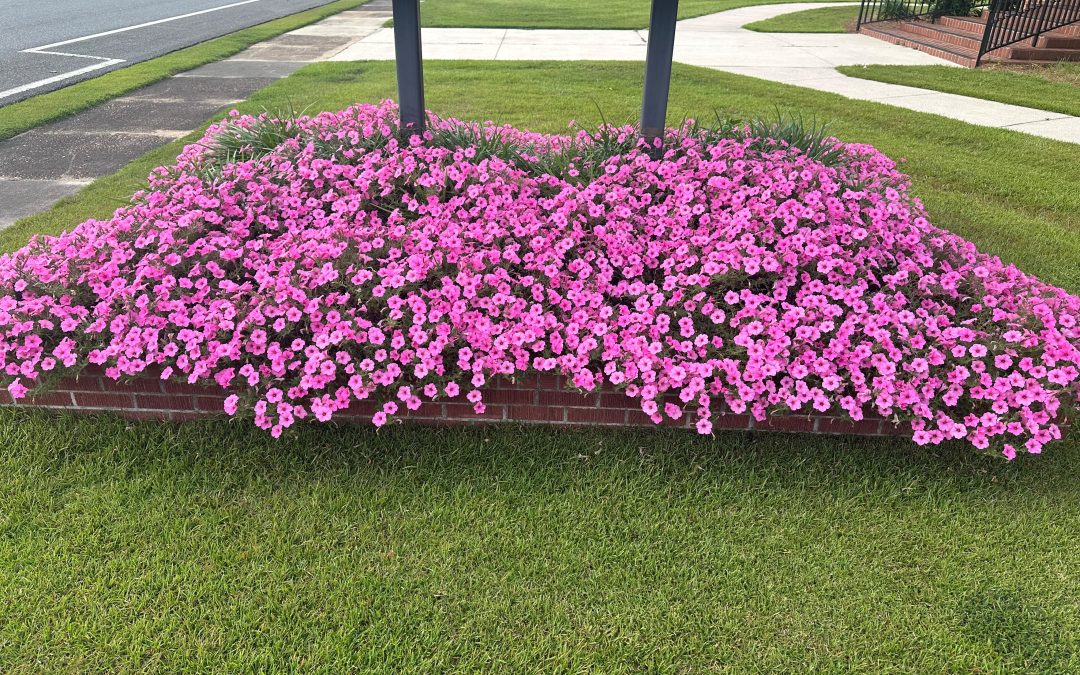
by Daniel J. Leonard | Jul 11, 2025
Normally, when one thinks of flowers that can take Florida’s summer heat, Petunia isn’t the first species that comes to mind, certainly not for me. For our northern neighbors, Petunias are one of the most popular summer bedding plants; their warm days and cool summer nights are perfect for Petunias. But, in the deep south, we are forced to grow Petunias in the cool months before the summer heat melts them. However, with the introduction of Wave Petunias back in 1995, the idea of a heat tolerant hybrid Petunia that could extend flowering was born. Then a decade later in 2006, Proven Winners debuted the next evolution of heat tolerant Petunias came along, the ultra-tough Supertunia Series, and disrupted everything we thought we knew about growing Petunias.
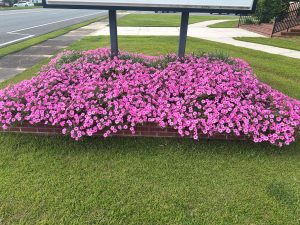
Supertunia Vista® Bubblegum® in mid-June 2025. Photo courtesy of Daniel Leonard.
There are several sub-series of Supertunia, all are good in my experience, but my favorite and the most resilient to heat is definitely the Vista® series, specifically the cultivar Vista® Bubblegum®. Vista® Bubblegum® is a massively growing Petunia that can spread in excess of 4’ and possesses vivid pink flowers with dark pink veins. Adding to the appeal of Vista Bubblegum is its self-cleaning nature, meaning no deadheading is required and it will flower more or less continuously throughout the life of the plant. However, the most outstanding aspect of the plant is its heat tolerance (for a Petunia). In general, Petunias in the Panhandle are planted in the fall, grow through the *usually* mild winter months, flower in the spring and then begin to languish in the heat of May-June. Vista® Bubblegum® chooses instead to laugh at the heat and mine (planted in early November) are still going strong, unfazed by the heat, in the second week of a very hot July. This plant just won’t quit. Pretty impressive stuff.
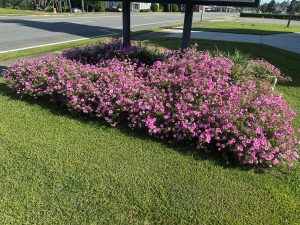
Supertunia Vista® Bubblegum® beginning to look a little tired in mid-July 2025 but still going strong! Photo courtesy of Daniel Leonard.
For best results with Vista® Bubblegum® and all other petunias, be sure to site in a location with full sun and keep regularly watered and fertilized, especially if grown in containers, as these prolific bloomers require a lot of energy to support the months-long flower show. Unfortunately, unless you already have Vista® Bubblegum® in your garden, you’ll have to wait until the fall to find more in nurseries, but these plants and its series siblings are well worth the wait! Plant a few this fall and enjoy beautiful color throughout next spring and summer.
For more information on growing petunias or any other horticultural topic, contact your local UF/IFAS Extension County office. Happy gardening!
by Molly Jameson | Jun 26, 2025
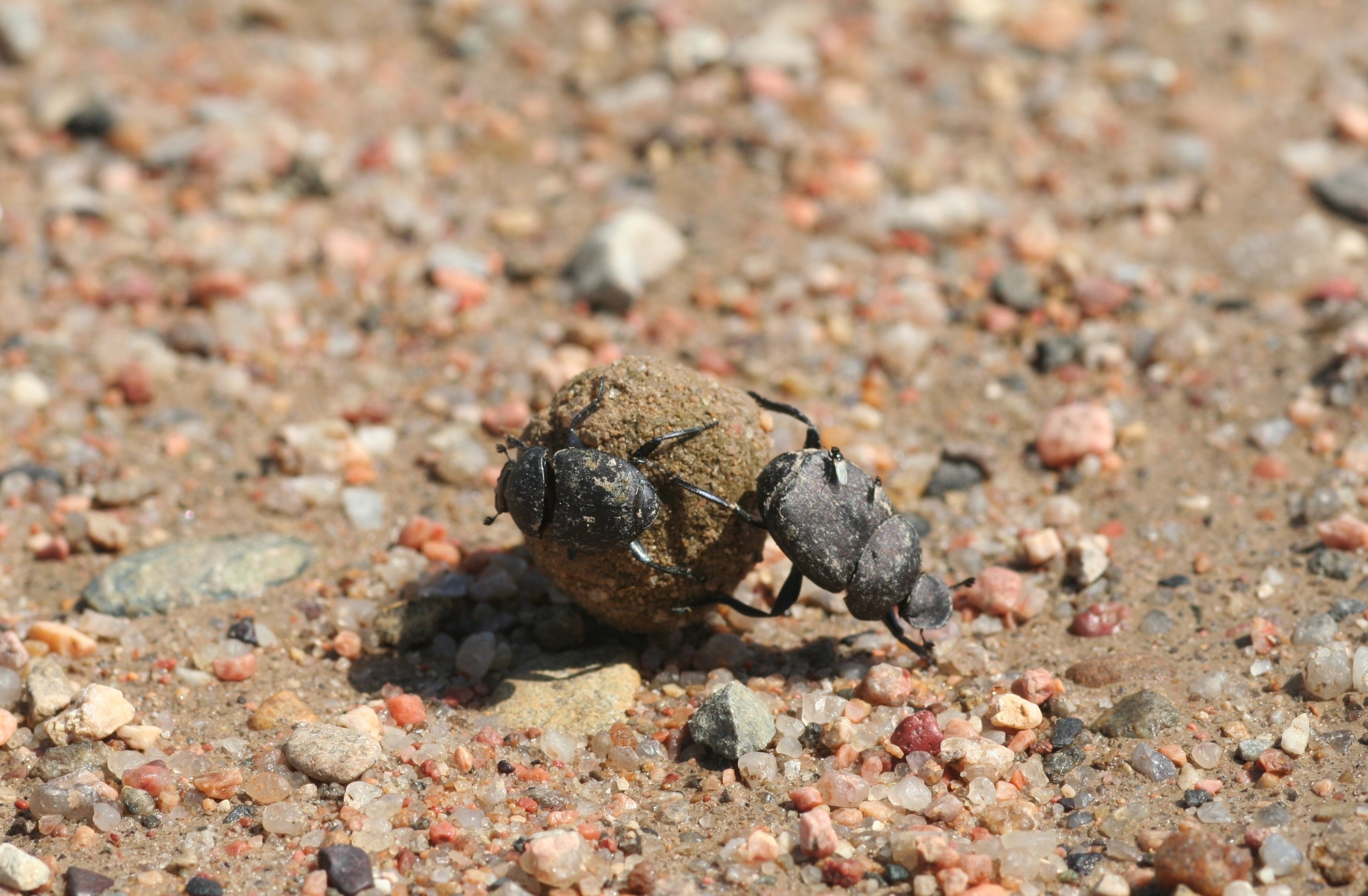
A pair of Canthon imitator beetles with a dung ball – the larger female pushes while the smaller male rides. This rolling behavior is shared with its close Florida relative, the common tumblebug (Canthon pilularius). Photo by Whitney Cranshaw, Colorado State University, Bugwood.org.
Dung Beetles of the Florida Panhandle
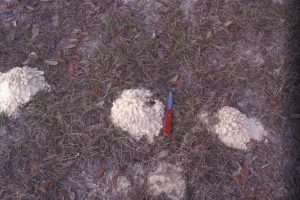
Mounds of excavated sand mark the tunnel entrances of Peltotrupes profundus in a scrubby Florida landscape. Photo by Lyle Buss.
There aren’t many creatures that can stir up a mix of admiration – and possibly some mild disgust – like the dung beetle. But if you spend much time around pastures, the woods, or even in your own garden, you might be surprised to learn these literal poop-pushers are the unsung heroes in local ecosystems – especially when it comes to soil health.
Dung beetles, which are primarily members of the Scarabaeidae family, specialize in feeding on and burying animal feces. That might not sound glamorous, but they more than earn their keep in the ecosystem. These beetles break down waste, aerate the soil, recycle nutrients, and reduce parasite loads in pastures. By quickly burying dung, they limit fly breeding and prevent harmful bacteria from hanging around longer than necessary.
In our part of Florida, where livestock, wildlife, and backyard chickens are common, dung beetles can play a quiet but essential role in keeping both landscapes and gardens healthier. While you might not see them directly in your raised beds, the soil health benefits they bring to the wider environment ripple out in ways gardeners can appreciate.
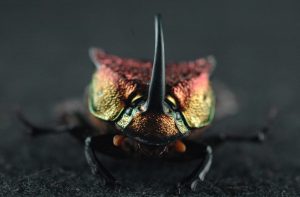
A male rainbow scarab (Phanaeus vindex) with the distinctive horn used in battles over dung. This native beetle is one of Florida’s most colorful nutrient recyclers. Photo by Joseph LaForest, University of Georgia, Bugwood.org.
Not all dung beetles are the ball-rolling athletes we imagine. In fact, most species in Florida are what we call tunnelers – they bury dung directly underneath where it lands, creating little underground pockets of fertility. Others are dwellers, who live inside the pile and lay their eggs right there.
While most of our local dung beetles are underground specialists, we do have at least one native species that performs that famous backward march. If you’re out walking after a summer rain, you just might spot a shiny black beetle with spiny legs rolling a dung ball twice its size – just one of the many native species quietly doing their part beneath our feet.
Native Dung Beetles of North Florida
While most people wouldn’t recognize a dung beetle if it landed on their compost pile, a surprising number of native species are hard at work across the Panhandle – from open fields to pine flatwoods to the edges of suburban backyards.
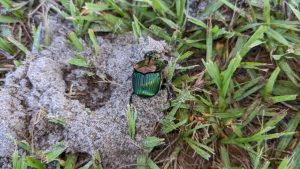
A female fiery scarab (Phanaeus igneus) emerges from a sandy tunnel in the Florida Panhandle. Photo by Erik Lovestrand, UF/IFAS.
One of the flashiest is the rainbow scarab (Phanaeus vindex), a heavy-bodied tunneler with a brilliant metallic sheen – often green or blue with coppery highlights. Males sport a single, curved horn and are known to spar over fresh dung like tiny armored knights. They’re most active in the warmer months and are common in both wild and grazed areas.
Another native jewel is the fiery scarab (Phanaeus igneus), which also shines with a coppery or red metallic glow. A Florida subspecies, P. igneus floridanus, occurs across central and northern parts of the state. These beetles prefer sandy soils and natural areas like longleaf pine uplands or scrub habitats, quietly tunneling through dung from wildlife or livestock.
And then there’s the Florida deepdigger scarab (Peltotrupes profundus), an endemic species found only in Florida. This dark, robust beetle creates conspicuous sand mounds in scrubby or pine-covered landscapes. Below those mounds? Tunnels that can run several feet deep. These beetles aren’t exclusive dung feeders – they mix organic matter into the soil, creating long-lasting soil channels that help roots breathe and water move more freely.
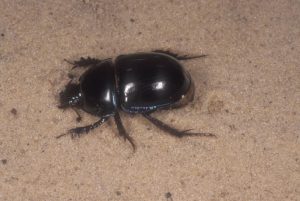
Adult Peltotrupes profundus, a Florida-endemic beetle known for its deep tunnels in sandy soils. Photo by Lyle Buss.
Finally, we have one native species that actually does roll its dung: the aptly named common tumblebug (Canthon pilularius). This smaller black beetle sculpts dung into neat balls and rolls them away to bury. They’re usually seen in open areas and pastures during the warmer seasons. If you spot one, enjoy the show – they’re fast, efficient, and usually gone in minutes.
Non-Native Dung Beetles in Florida
Several non-native dung beetle species have also become established in Florida, introduced in the 1970s to help manage cattle manure in pastures. These include species like the gazelle dung beetle (Digitonthophagus gazella), bull-headed dung beetle (Onthophagus taurus), and the sandy dung beetle (Euoniticellus intermedius). All three are tunnelers that quickly bury fresh dung, reducing fly populations and improving soil fertility. They’re now widespread in pastures across North Florida, especially in the summer and fall. Another common non-native is the European dung beetle (Aphodius fimetarius), a small red-and-black species that acts as a dweller, living and breeding directly within the dung pile itself.
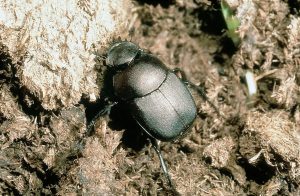
The common tumblebug (Canthon pilularius) is one of the few native dung beetles in Florida that rolls dung into balls. Photo by Kansas Department of Agriculture, Bugwood.org.
While none of these introduced beetles are currently considered invasive, some researchers have raised concerns about how they might compete with native species for dung – especially in heavily grazed pastures. That said, most tend to stick close to livestock areas and haven’t been shown to disrupt natural ecosystems in a meaningful way.
Soil Helpers, Garden Allies
For gardeners and farmers alike, dung beetles are some of our most efficient natural tillers. Their tunneling mixes organic matter deeper into the soil profile, improving structure and water infiltration. That means fewer compaction issues and better moisture retention during our dry spells. In pastures, studies have shown that they can improve grass growth and reduce runoff – pretty remarkable for something that lives in poop.
If you’re already focused on fostering a sustainable landscape, be sure to give dung beetles a spot on your list of wildlife to appreciate and protect. In a world full of tidy lawns and picture-perfect beds, dung beetles remind us that beauty isn’t always what you see on the surface. Sometimes, the real work is happening just below it.
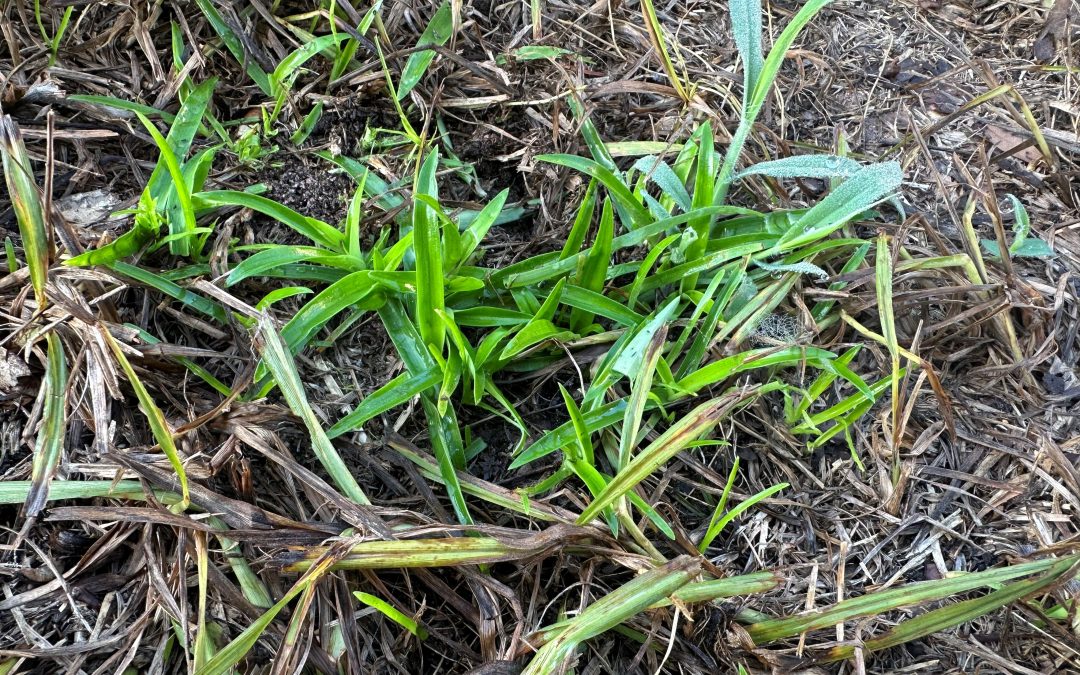
by Daniel J. Leonard | Jun 5, 2025
The Panhandle’s dreaded summer heat has finally arrived in force and has brought with it one of the most difficult to control lawn/landscape weeds, our annual enemy Doveweed (Murdannia nudiflora). Doveweed is characterized as one of the world’s worst weeds due to its broad range of growing conditions, ability to root along its stems, forming mats as it grows, massive seed production (each plant can produce up to 2,000 seeds per year), and inconspicuous nature – it looks like a grass to the untrained eye. So, what can gardeners do to control Doveweed that’s already up this year and prevent it next summer? Let’s find out.
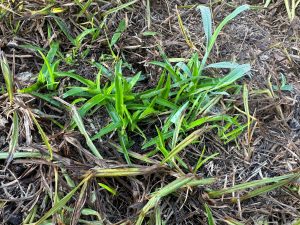
Doveweed emerging in a bare patch of a Centipedegrass lawn in late May 2025. Photo courtesy of Daniel Leonard.
First, the best prevention for all weeds, Doveweed included, is a healthy lawn/landscape. Ensuring healthy, thick Centipedegrass turf and landscaped beds that don’t allow light to hit bare soil goes a long way towards reducing the overall weed load lawns and landscapes can experience. For lawns, this can be achieved through mowing regularly at the proper height for your turfgrass (2.5” or so for Centipedegrass), irrigating no more than 0.75”-1” per week in the absence of rain, limiting stress from overfertilization, and removing excess thatch. In landscapes, preventative weed control focuses on limiting overwatering/fertilization and maintaining a 2-3” organic mulch layer of pinestraw, pine bark, leaves, wood chips, etc. Adopting these practices can greatly reduce the occurrence of weeds in your yard, however they will not eliminate weeds altogether and supplemental chemical weed control is often necessary.
Unlike Crabgrass, Florida Pusley, and other commonly encountered Panhandle annual weeds that emerge when the soil begins to warm in early spring (usually late February-March), Doveweed waits until mid-April-May (soil temperatures of 70-80 degrees F). All these annual weeds are best controlled by preemergent herbicides, like Indaziflam (Specticle G), before seeds germinate. For Doveweed, that means the first preemergent application should occur mid-April with a follow-up application 6-8 weeks later. However, for this year that opportunity is behind us and our only option is post emergent herbicides.
Which postemergent herbicide you choose depends on if your Doveweed issue is in turfgrass or in landscaped beds. In landscaped beds, the primary control option is either hand pulling or spot treating Doveweed with a 41% glyphosate product (Roundup and other generic products) at a rate of 3% (3-4oz glyphosate/gal). As glyphosate is a non-selective herbicide, be sure to not get any overspray on any ornamental plant foliage. In turfgrass, Doveweed control becomes a little more difficult. You essentially have three options – atrazine, a generic 3-way broadleaf product, or a commercial grade broadleaf product. Though it provides very good control of Doveweed and has pre-emergent properties to help discourage future weeds, I don’t prefer atrazine because it has a high potential to leach into groundwater following heavy rains in sandy soils, which describes much of the Panhandle. The generic 3-way products (usually a mix of Dicamba, Mecoprop, and 2,4-D) are fairly effective on Doveweed, however follow-up applications are usually required and the 2-4D component can be harsh on Centipedegrass at the higher label rates required for Doveweed control. Though somewhat expensive, the best post emergent option for most people is probably a commercial grade product like Celsius WG. Celsius WG is a very strong post emergent broadleaf herbicide that is very effective on Doveweed and is also very safe on Centipedegrass, even in hot weather. If the cost of the product (>$100) is off-putting, it is helpful to remember that even at the highest labelled rate, a 10 oz Celsius WG bottle goes a long way, enough to cover several acres of lawn.
* Regardless of what method you choose, be sure to get after emerged Doveweed seedlings early, before they mature and begin flowering – even the strongest post emergent herbicides work better on young weeds.
While Doveweed is a nasty little plant that is perfectly capable of taking over a lawn or landscaped bed, there are a variety of preventative and control options available. Using a combination of the above techniques should help achieve lasting Doveweed controls in future seasons! For more information about Doveweed and other summer annual weed control in lawns and landscapes, contact your local UF/IFAS Extension County office.

by Ian Stone | Nov 21, 2024
Not all trees and woody species are welcome in the landscape. In fact, some woody species can be pesky and problematic and for lack of a better term “weeds”. Despite the fact that some of these species are native trees, bushes, and vines, many can be aggressive and problematic in the home landscape and urban settings. If you have ever cared for a flower bed or garden in the Panhandle, you are probably well acquainted with these and have pulled seedlings and small saplings out of beds, hedges, and seemingly any other nook and cranny of your landscape. If you cut them off using loppers or a saw you also know how aggressively they resprout and how extensive their root system can become. Vegetation grows quickly and often aggressively in our humid sub-tropical climates. If you leave an area of land vacant for very long here, it quickly becomes a thicket in no time. Some of our oaks, particularly water and laurel oaks, can be pesky and troublesome. It seems like I am constantly battling problem oaks in my home landscape, with varying degrees of success. I will pull out, cut out, and apply herbicide only to look up and see a substantial oak sapling rocketing up through azaleas or other hedges. Without fail this is a water or laurel oak nearly 100% of the time, with some other hardwood trees and shrub species thrown in occasionally.
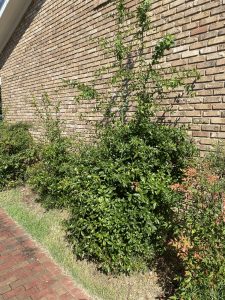
Oak sapling overtaking shrubbery in a local landscape Escambia County, FL Photo Credit: Ian Stone
What is the best way to tackle these pesky woody “weeds” when they cause persistent problems and pop up in undesirable spaces? The answer is to either mechanically removal them or employ very careful and targeted herbicide application. As a professional forester I have spent a large part of my career controlling these brush species using a host of mechanical and herbicide control methods and very well planned prescribed fires. Obviously using large heavy machinery and prescribed fire in urban and suburban settings and landscapes is not an option but using hand tools for mechanical removal and herbicides where needed and best suited is a winning combo for the home landscape.
First you want to determine what species you are dealing with and what stage of development it is in. As I mentioned, water oak and laurel oak are usually the problem oaks we encounter and can reproduce at extremely high rates and create undesirable crowded stands of stunted oak. These species are what foresters call early successional, meaning they tend to establish in forest openings and areas impacted by a disturbance such as a hurricane or windstorm. They produce large amounts of small acorns and grow very fast and they also have poor characteristics where they are susceptible to wind throw and disease. Effectively, they reproduce heavily, grow fast, and die young; that is their natural adaptation and life cycle and what causes them to be pesky and weedy in the home landscape. We don’t realize it, but our home lawns and flower beds create the perfect early successional habitat for these oaks and other brush species such as yaupon holly, titi, wax myrtle, and others. It doesn’t stop there – in heavily shaded areas, very shade tolerant oaks, brush, and vines tend to become established. Vines such as Virginia creeper, greenbriers (Smilax spp.), pepper-vine, and others are particularly annoying as these woody species also love to grow up in fences, particularly chain link, and are difficult to remove.
So what are the best methods to handle problem woody species in the home landscape? The best option is to catch them as seedlings and young plants and pull them up by the roots and all. If you can do this, you will avoid issues with resprouting. If you have larger, more well-established brush and small trees in your landscape, you can cut them back close to the ground, but you are likely to have issues with resprouting. This can be very frustrating and can result in a persistent problem. By consistently cutting these back you may be able to exhaust the plant’s reserve, but this is unlikely. Depending on the size of the root system you may be able to dig up the roots using some elbow grease and a shovel or mattock, but if significant roots are left behind, some woody species can resprout from the remaining roots. This is when simply cutting off the main stem or other mechanical methods often are not sufficient for long term control.
When dealing with well-established woody species with a significant stem size, using a properly labeled and effective herbicide can be a big time and hassle saver. You want to use a herbicide that is labeled for hack and squirt applications and/or cut stump applications. Many brush control and tough brush herbicides are labeled this way and can be applied using these methods. Herbicides with the active ingredients of triclopyr or glyphosate are the most effective for these methods and readily available for home use. Triclopyr products are usually the most effective on tough brush and woody species. Make sure the species you are targeting is listed on the label and follow the label directions exactly for the methods and concentrations to apply the herbicide correctly.
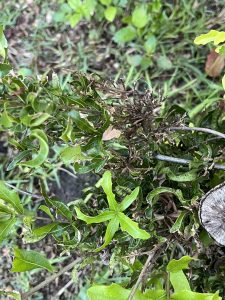
Oak resprouting from stump after herbicide treatment. Note the deformed leaves on the regrowth showing herbicide damage. Photo Credit: Ian Stone
Cut stump and hack and squirt applications require a bit of a different method of application. Instead of spraying foliage, you apply the herbicide into fresh cuts using a squirt bottle or a paint brush. You should wear proper protective equipment when working with any herbicide and this is also listed in the label. Long sleeves and pants along with chemical resistant gloves and eye protection is usually the minimum recommended. For hack and squirt, make a series of connecting cuts in a ring around the problem stem and squirt the herbicide mixture into the fresh cuts using the squirt bottle. For cut stump treatments cut the stem(s) of the problem tree or shrub off slightly above the ground and apply the mixture using a paint brush or squirt bottle, focusing on the outer portion of the stump right next to the bark. These methods work by introducing the herbicide to the cambium layer, which is the actively growing and live tissue just under the bark in woody plants. By doing this it will travel through the tissue and kill both the roots and stems. It is very important that the cuts are fresh, and the application must be made as soon as possible after the cuts are completed. Once the brush is killed back, you can wait for the stem or stump to rot or remove it once it has completely died. This method is effective at controlling resprouting but is not 100% effective on all applications. If the woody plant in question continues to resprout, you can make fresh cuts and reapply. An advantage of this method is it can be done in winter even when the plant is dormant, as it does not rely on foliage to uptake the herbicide. That means you can use it year-round, and you can take advantage of the cooler winter weather to do this labor-intensive work.
With careful work and proper technique, these methods can be beneficial to control persistent brush problems in the home landscape. When using herbicides it is very important to be aware of off target damage to desirable plants. One of the advantages of hack and squirt and cut stump applications is that they are very targeted and minimize issues with off target damage and drift. Care should be taken not to get the herbicide mixture on the stems of desirable shrubs and trees, and they can penetrate the bark and do damage, especially on thin barked species. If you have questions about how to properly use a herbicide or reading the label contact your local extension office.
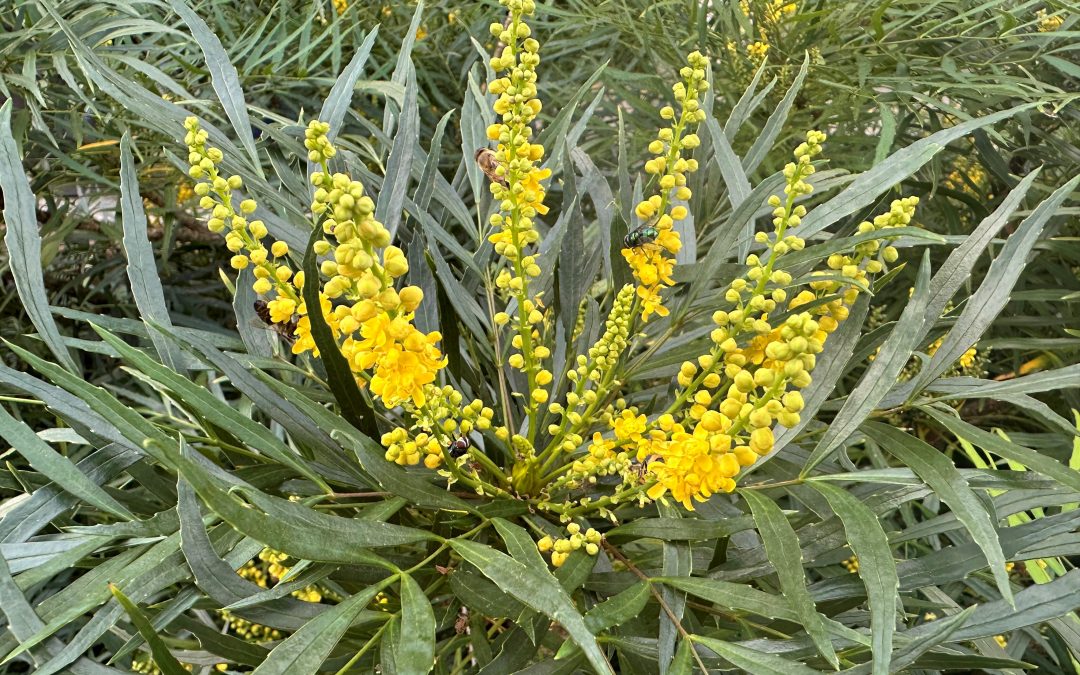
by Daniel J. Leonard | Nov 13, 2024
One of my favorite landscape plants is blooming right now in Panhandle landscapes – ‘Soft Caress’ Mahonia. ‘Soft Caress’ was first introduced into the commercial nursery trade in 2006 and included in the Southern Living Plant Collection, but didn’t achieve garden fame until 2013 when it won first place in the Royal Horticultural Society’s (RHS) prestigious Chelsea Flower Show. I first planted a group of ‘Soft Caress’ about ten years ago and as those plants have matured, so too has my appreciation for them. The following are a couple of my favorite outstanding aspects of these small shrubs.
Fall Flowers. Other than camellias, there isn’t a lot else in Panhandle landscapes blooming from mid-November to January and ‘Soft Caress’ Mahonia helps fill that flower void. Brilliant yellow flower spikes rise above the deep-green fernlike foliage and very welcome in this otherwise drab and dreary gardening season.

‘Soft Caress’ Mahonia’s winter flowers are excellent pollinator attractors. Photo courtesy Daniel Leonard.
Quick growing but small statured. If you’ve gardened very long, you’ll know this is a tough ask! Plants that reach mature size relatively rapidly but also don’t get very big are a rare breed. ‘Soft Caress’ Mahonia grows quickly but also maxes out in size rather quickly – mine are very easily maintained at 3-4’ in height with a single annual trim.

~10-year old ‘Soft Caress’ Mahonia Shrub. Photo courtesy Daniel Leonard.
Extremely tough and adaptable. My Mahonia plants have persisted through drought, hurricanes, floods, and freezes and have never looked better. These little plants are simply tough. They’ve had no disease issues and no pest problems (except for a little deer browsing one year, but that appears to be an isolated incident). While they prefer shade, they can also handle several hours of morning sun without incident.
‘Soft Caress’ Mahonia is a standout plant that fills a mostly flowerless period in landscapes, fills its designated landscape spot quickly but won’t outgrow it, and is truly tough. Add a couple to your landscape this winter!
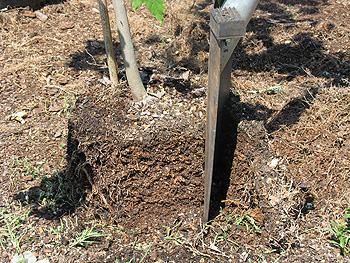
by Sheila Dunning | Nov 6, 2024
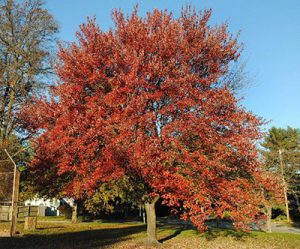
Red Maple structure IFAS Photo: Hassing, G.
Though the calendar says November, the weather in Northwest Florida is still producing summer or at least spring-like temperatures. The nice days are wonderful opportunities to accomplish many of those outside landscape chores. But, it is also a good time to start planning for next month’s colder temperatures. Since we don’t experience frozen soil, winter is the best time to transplant hardy trees and shrubs. Deciduous trees establish root systems more quickly while dormant; versus installing them in the spring with all their tender new leaves.

Remove an inch or more for extremely rootbound trees.
Here are a few suggestions for tasks that can be performed this month:
- Plant shade trees, fruit trees, and evergreen shrubs.
- Do major re-shaping of shade trees, if needed, during the winter dormancy.
- Check houseplants for insect pests such as scale, mealy bugs, fungus gnats, whitefly and spider mites.
- Continue to mulch leaves from the lawn. Shred excess leaves and add to planting beds or compost pile.
- Replenish finished compost and mulch in planting beds, preferably before the first freeze.
- Switch sprinkler systems to ‘Manual’ mode for the balance of winter.
- Water thoroughly before a hard freeze to reduce plants’ chances of damage.
- Water lawn and all other plants once every three weeks or so, if supplemental rainfall is less than one inch in a three week period.
- Fertilize pansies and other winter annuals as needed.
- Build protective coverings or moving devices for tender plants before the freeze warming.
- Be sure to clean, sharpen and repair all your garden and lawn tools. Now is also the best time to clean and have your power mower, edger and trimmer serviced.
- Be sure the mower blade is sharpened and balanced as well.
- Provide food and water to the area’s wintering birds.
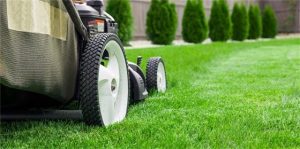
Mowing a lawn. Photo Credit: University of Florida/IFAS





















